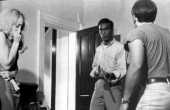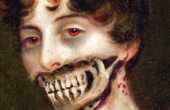Heather Lambert
Heather is a horror-obsessed writer whose work can be found in Imprint, Update Magazine, Lamar Journal of the Humanities, and Hungarian Journal of English and American Studies
Contributor I
- Lurker
- Sharp-Eyed Citizen
- Article of the Month
- ?
- Articles
2 - Featured
2 - Comments
19
- Ext. Comments
9 - Processed
4 - Revisions
4
- Topics
4 - Topics Taken
1 - Notes
15
- Topics Proc.
15 - Topics Rev.
2
- Points
673 - Rank
197 - Score
328
Latest Articles
Latest Topics
Why Are So Many Gothic Stories Geared Towards/Concentrated on Children?Coraline, IT, Stranger Things, Pan’s Labyrinth, The Babadook…the Gothic and horror genres appear to have a fascination with children. Does it stem from our primal instinct to protect our offspring from threat? Does it illustrate how our childish fears never really leave us? Also, are these texts really geared towards children, or to the adults watching with their children? Or both? So many questions with some possibly fascinating answers.
|
Where Are the Female Monsters?With the recent release of The Shape of Water, we have been reminded of our love of monsters. But when it comes to them, they are so often male. While female monsters exist, they tend to be either human-coded (think recent vampires) or sexy (think mermaids). But where are the truly terrifying females? The closest I can personally come up with is the Other Mother from Coraline. You may explore the significance of what a female monster would bring to the table.
|
The Evolution of the Popular MonsterMonsters have greatly evolved in popularity throughout time. From the vampires of Dracula’s era to the witches of the 1990s to the zombies of the 2010s, we have seen certain monsters grow in popularity to reflect the social and political anxieties of their time. Create an outline of the recent history of monsters, and predict what types of monsters the current era will rely on for social critique and escapism.
|
The Power of Storytelling as Presented in Life of PiStories are what shape our reality–both on a personal and a widespread cultural scale. They directly affect how we understand everything, from everyday occurrences to the larger questions in life. Stories also play a large role in the world religions through both oral and written types of scripture, including myths, historical accounts, poetry, letters, etc. The novel Life of Pi reflects on the impact of stories in relation to religion and history. Examine questions of "truth" and "scientific fact" in contrast to "myth" and "spirituality" and how these themes are presented in both the novel and the movie. Also analyze the apparent human need for fantastical stories as presented in the movie–does this imply that religion is simply a way for humans to cope with the difficult events of life? Or does it have a larger implication, such as that "truth" or "fact" in life is not always tangible, and does not always have the importance we place upon it? There are many philosophical questions that can be explored regarding stories and reality in Life of Pi, and this topic is certainly open to suggestions! |
Latest Comments
| Why do the Women of Game of Thrones Suffer So Much? | |
I’m so glad to have had a positive influence on your impression of zombies! I hope you enjoy it 🙂 | Pride and Prejudice and Zombies: Is Jane Austen Rolling in Her Grave? |
Fantastic article! Thank you for mentioning Pocahontas. Adaptations of one art form to another are one thing, but adapting real-life occurrences can be trickier, especially when representing marginalized communities. Artists need to practice respect and authenticity when tackling such projects. | The Art of Adaption |
This is amazing. I can totally see how this survivalist narrative can create a population that craves to be heroes and reject the powers that be, and Trump certainly fits the “outsider” image. Love the comment about the red baseball cap. Unfortunately Trump isn’t as outside of the system as his followers seem to think he is. In the end, he’s just capitalizing on this culture. Thanks for the article! | How Trump Won: Heroes, Villains and Surviving the Apocalypse |
I love your commentary on the show’s complication of morality–one of the key strengths of the horror genre. What is evil, what is good? And what kind of things change our answers to these questions? Great article! | The Walking Dead: The transformation of Rick Grimes |
It’s so important to bring dystopian literature to the forefront of study, as I believe it is one of the key indicators of a society’s struggles, biases, and human experiences. So much can be interpreted from these texts, and you do a great job summing up some of the keystones of the genre. Love this! | What is the Purpose of Dystopian Literature? |
A great, short, comprehensive guide! When I come back to writing this summer, I’ll return to this article 🙂 | The "Write" Way |
Thanks so much, I appreciate your thoughts! I find the theory that economic/political downturns lead to a growth in public interest in zombies to be particularly convincing, especially now in our complicated and divided Western political climate. It will be interesting to see what other types of monsters rise from the grave over the next few years. | Pride and Prejudice and Zombies: Is Jane Austen Rolling in Her Grave? |


A really great article! I, too, have struggled with the violence against women in GoT, mostly because as a cis woman, it’s hard to watch. It makes the show feel very heterosexual-cis-male-centred. And yet, there are scenes where these women overcome their hardships in very feminist ways. It’s hard to navigate, but you put it into fine words!